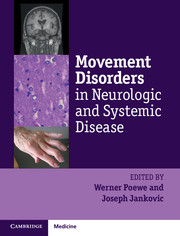Book contents
- Frontmatter
- Contents
- List of contributors
- List of videos
- List of abbreviations
- Preface
- Section I General principles
- Section II Movement disorders in systemic disease
- Section III Iatrogenic and toxic movement disorders
- Section IV Movement disorders in general neurology
- Chapter 17 Movement disorders in stroke
- Chapter 18 Movement disorders in multiple sclerosis
- Chapter 19 Movement disorders in neoplastic brain disease
- Chapter 20 Movement disorders in encephalitis
- Chapter 21 Sleep-related movement disorders
- Chapter 22 The borderland between epilepsy and movement disorders
- Chapter 23 Movement disorders associated with neuromuscular disorders and peripheral neuropathies
- Section V Systemic complications of movement disorders
- Index
- Plate Section
- References
Chapter 23 - Movement disorders associated with neuromuscular disorders and peripheral neuropathies
from Section IV - Movement disorders in general neurology
Published online by Cambridge University Press: 05 April 2014
- Frontmatter
- Contents
- List of contributors
- List of videos
- List of abbreviations
- Preface
- Section I General principles
- Section II Movement disorders in systemic disease
- Section III Iatrogenic and toxic movement disorders
- Section IV Movement disorders in general neurology
- Chapter 17 Movement disorders in stroke
- Chapter 18 Movement disorders in multiple sclerosis
- Chapter 19 Movement disorders in neoplastic brain disease
- Chapter 20 Movement disorders in encephalitis
- Chapter 21 Sleep-related movement disorders
- Chapter 22 The borderland between epilepsy and movement disorders
- Chapter 23 Movement disorders associated with neuromuscular disorders and peripheral neuropathies
- Section V Systemic complications of movement disorders
- Index
- Plate Section
- References
Summary
Introduction
This chapter addresses the motor phenomena and involuntary movements that accompany peripheral neuropathies, mononeuropathies, neuromuscular junction disorders, and primary muscle disease. Spontaneous motor activity in peripheral neuropathies, such as fasciculation, fibrillation, myokymia, and neuromyotonia, is generated by ectopic discharges in motor axons and may present as cramps or muscle stiffness. Characteristic clinical and electromyographic features differentiate these syndromes from cramps that arise from metabolic or myotonic myopathies. Involuntary movements such as myoclonus or tremor occasionally accompany a neuropathy or peripheral nerve injury. The mechanisms whereby the altered peripheral signals recruit motor pathways in the central nervous system and generate these movements are complex and still poorly understood.
Myokymia and neuromyotonia in peripheral nerve hyperexcitability syndromes
The term “peripheral nerve hyperexcitability syndrome” (Hart et al. 2002) refers to continuous motor unit and muscle fibre activity generated by discharges in motor axons. The syndrome has been reported in the literature using descriptions of clinical phenomena interchangeably with electromyographic terminology (Thompson 1994; Thompson and Thomas 2005). Myokymia refers to clinically visible undulating, wave-like, or worm-like rippling of muscle and the electromyographic finding of continuous muscle activity with doublet, triplet, and multiple motor unit discharges. Myokymia is often accompanied by muscle fiber discharges, fasciculation, and repetitive trains of high frequency discharges described as “neuromyotonia.” This term was originally used to distinguish delayed muscle relaxation after voluntary contraction in peripheral nerve hyperexcitability syndromes from myotonia (caused by muscle fiber membrane hyperexcitability).
- Type
- Chapter
- Information
- Movement Disorders in Neurologic and Systemic Disease , pp. 352 - 362Publisher: Cambridge University PressPrint publication year: 2014



